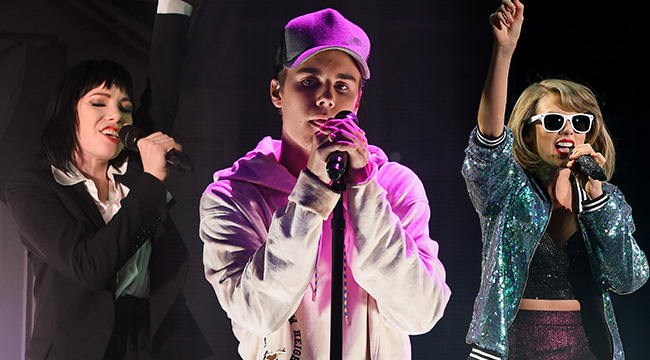
It might have taken far too long, but 2015 is the year we finally did it. After years and years of poptimist thinking forcing Selena Gomez and Justin Bieber reviews to rub elbows with Sufjan Stevens interviews and Oneohtrix Point Never announcements, after being told again and again that the internet would reveal genre to be nothing more than a marketing tactic and destroy it accordingly, it finally happened. 2015 is the year pop broke.
No, not in the traditional (or at least music-publication traditional) sense of the word. Pop music can’t have a breakout year. By definition, it’s already famous — it is fame. But the walls around “Pop Music” have finally started to crumble. They are being chipped away by indie outsiders who recognized the artistry behind the hits and also wanted in to get a taste of some sweet hooks. Megastars are aiding them along by sabotaging the walls from the inside, just to see what life is like on the outside (and gain a little bit more critical cred in the process).
More than any before, this year seemed like the first time that artists adopted the tack of the most recent wave of cultural critics, who claimed that elitism is bad and that all forms of music have their own merits. Someone recording noise pop in their bedroom is no less worthy of consideration than Taylor Swift and, on the flip side, being well-known doesn’t keep you from making great music. There’s room to enjoy Justin Bieber and Grimes, and in 2015, the artists themselves made it easier than ever to fit both in your headspace. Pop moved away from the center while indie stars found their inner-Max Martin.
Let’s start on the pop side with Taylor Swift and Carly Rae Jepsen, two stars who dominated the year commercially and critically, respectively. Taylor Swift didn’t move her own music much toward the indie sphere on 1989, but her consistent dipping in the pool with smaller indie-leaning artists made waves (and that’s before we even get into her all-encompassing, genre-is-meaningless #Squad movement). In fact, the biggest thing that Taylor did in 2015 was release an album last year full of songs that were so great, they could be put through any number of sad-bro indie permutations and still come out sounding great.
While I’d have to agree with folks who say “We shouldn’t need Ryan Adams to prove that T-Swift makes great songs,” the fact of the matter is for some folks, he did. His covers of 1989 pulled the wool from the eyes of the types of dudes (and they are usually dudes) who dismiss pop music outright. Whether that’s a statement about artists or audiences is a question for another day.
Carly Rae Jepsen went in another, more active direction. She didn’t have the cultural cachet to advocate for the indie sounds she loved or be covered by a beloved underground figure. To most, Carly Rae is known for being the force behind the musical meme generator “Call Me Maybe” which made her the supposed embodiment of vacuous pop, especially after rushing out her last album Kiss to capitalize on the success of a million “I just met you” jokes. Rather than kick back and accept her fate, CRJ buried herself in the studio. She enlisted a stable of indie-approved producers to approximate the nostalgic, synth-driven tracks that were indie’s sound du jour several years ago. Jepsen had something that the Sky Ferreira’s and Solange’s of the world didn’t. As someone who had been though the mainstream pop music wringer, she had an ear for earworms and no fear of bombastic and earnest choruses. (And yes, the involvement of Scooter Braun, Shellback and other pop music svengalis didn’t hurt.)
But the end result was the same. E-MO-TION was the poptimist’s ideal: an unquestionably pop album created with the goal of doing pop music numbers — albeit not as big as Taylor’s — that could still be appreciated for its artistic flourishes by indie-first critics. Alone, that would be worth celebrating, but E-MO-TION became a much bigger signifier of what was happening to the walls between pop and indie when paired with the work of another beloved Canadian.
Claire Boucher, better known as Grimes, chucked a totally unexpected bomb at the divide between pop and indie with her album Art Angels. Where Carly was incorporating the feel of indie pop, Grimes completely abandoned the minimalist synth sound that had been her trademark and proved that you can make blown-out, Jock Jams, stadium-ready pop music that is still worthy of deeper critical analysis.
Even more eye-opening than what Grimes did is how she did it. By handling almost all aspects of production herself, she brought a sense of auteurism to an album that sounds like it was made via a stable of hired gun, of-the-moment producers. “Slick” can’t keep being a dirty word in the face of songs as good as “Kill V. Maim.” It’s hard to hate on Diplo and then jump into “Venus Fly.” Hell, even a genre as loathed as pop-country gets a redeeming moment in her music-press-shade-throw “California.”
Here’s hoping that pop and indie continue on the path they set down together in 2015, snuffing out such snobbery with their every step. It’s long since been time for critical elitism to go, and death rattles rarely sound this fun.
